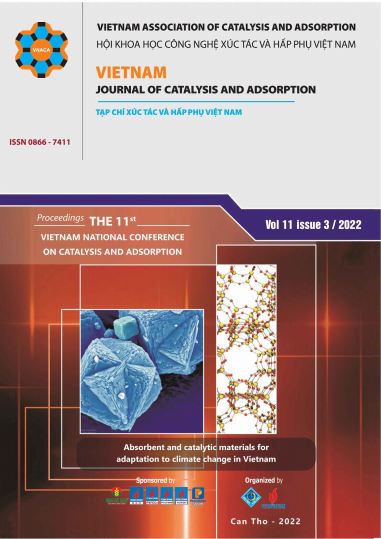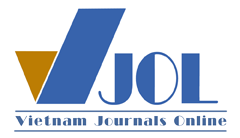Decomposition efficiency of some azo dyes in the systems consist of persulfate, zero-valent iron powder and UV light in water environment
DOI:
https://doi.org/10.51316/jca.2022.055Keywords:
Sulfate radicals, hydroxyl radicals, persulfate, zero-valent iron, UV lightAbstract
This research focused on surveying the decomposition efficiency of methyl orange, alizarin yellow and mordant black -T in the systems without and with UV light in water: alone zero-valent iron; alone persulfate; both zero-valent iron and persulfate. Results of research show that the decomposition efficiency some azo dyes are the highest in the systems of zero-valent iron/persulfate/azo dyes/UV and zero-valent iron/persulfate/azo dyes with the same reaction conditions. After 30 minutes of reaction, the decomposition efficiency of methyl orange, alizarin yellow and mordant black -T are 95.89 %, 90.99 % and 79.85 % in the zero-valent iron/persulfate/azo dyes/UV system and 73.65 %, 71.42 % and 58.94 % in the zero-valent iron/persulfate/azo dyes system. These results can be explained that persulfate has peroxide bond in molecular structure activated by zero-valent iron and UV light to generate in-situ free sulfate radical SO4−• (E0=2.6 V) and free hydroxide radical •OH (E0=2.8 V). These radicals are very active and strong oxidation property. They are agents to oxidize those azo dyes strongly in the water environment.
Downloads
References
B.T. Zhang, Y. Zhang, Y. Teng, M. Fan, Envi. Scie. & Tech. 45 (2015) 1756-1800. https://doi.org/10.1080/10643389.2014.970681.
D.N. Wordofa, Application of Iron Activated Persulfate for Disinfection in Water Treatment, University of California Press, California, 2014, p.116.
F.I. Haia, K. Yamamotob, K. Fukushi, Envi. Scie. & Tech. 37, (2007) 315-377. https://doi.org/10.1080/10643380601174723.
G. Shi, Oxidation of 2,4-D using iron activated persulfate and peroxymonosulfate, Lowa State University, 2015, p.59.
D. Shao, Y. Deng, C. Tan, S. Zhou, Env. Scie. Tech. 11 (2014) 881–890. https://doi.org/10.1007/s13762-013-0284-2.
K. Hunger. Industrial Dyes Chemisry, Properties, Applications, Wiley-VCH publisher, Frankfurt, 2002, p.235.
L. Zhao, Y. Ji, D. Kong, J. Lua, Q. Zhoua, Chem. Engi. 303 (2016) 458-466. https://doi.org/10.1016/j.cej.2016.06.016.
M. Peluffo, F. Pardo, A. Santos, A. Romero, Scie. of the Tota. Envi. 563 (2016) 649–656. https://doi.org/10.1016/j.scitotenv.2015.09.034.
M. Nie, C. Mengli, Envi. Engi. Jour. 25 (2010) 55-76 https://doi.org/10.1016/j.cej.2015.05.055.
P. Devi, U. Das, A.K. Dalai, Scie. Tota. Envi. 571 (2016) 643-657. https://doi.org/10.1016/j.scitotenv.2016.07.032.
R.J. Watts, Enhanced Reactant-Contaminant Contact through the Use of Persulfate in-situ Chemical Oxidation (ISCO), Washington State University, 2011, p.135.
S.A. Abo-Farha, Jour. of Amer. Scie. 6 (2010) 128-142. https://doi.org/10.4236/aces.2014.43031.
S.T. Ong, P.S. Keng, W.N. Lee, S.T. Ha, Y.T. Hung, Treat. Wate Jour 3 (2011) 157-176. https://doi.org/10.3390/w3010157
X. R. Xu, S. Li, Q. Hao, J. L. Liu, Y.Y. Yu, H.B. Li, Envi. & Bioe. 1 (2012) 60-81. https://doi.org/10.2175/106143016X14609975746848
Y. Yang, J. Jiang, X. Lu, J. Ma, Y. Liu, Envi. Scie. Tech. 49 (2015) 7330−7339. https://doi.org/10.1021/es506362e
Z. Wang, M. Xue, K. Huang, Z. Liu, Textile Dyeing Wastewater Treatmen, Huazhong University of Science and Technology Press, China, 2011, p. 145.











